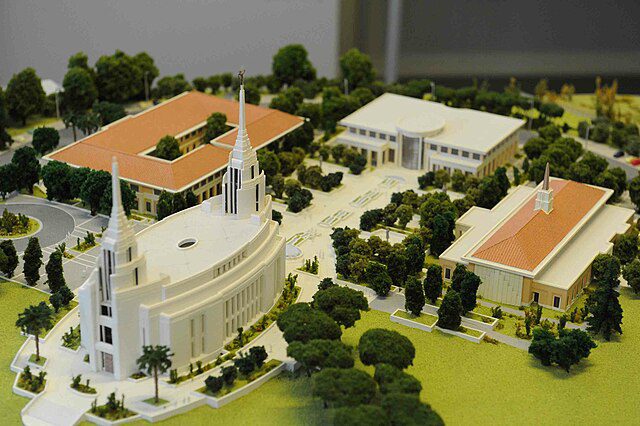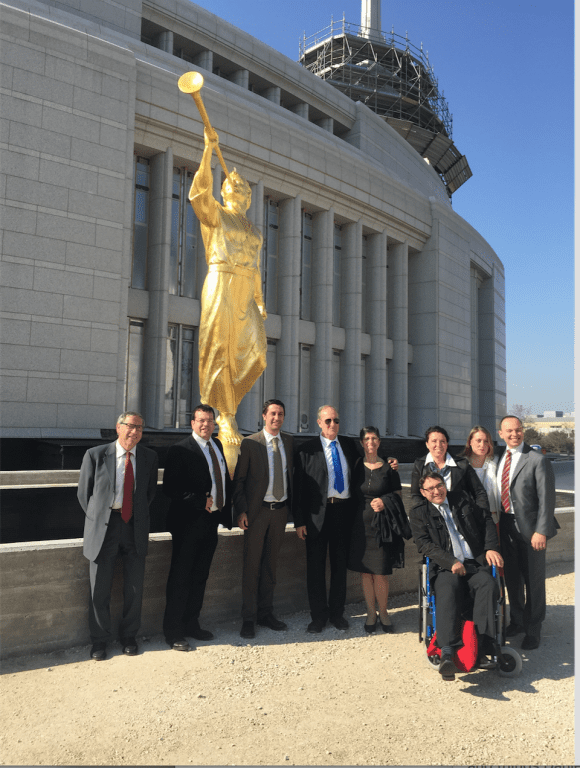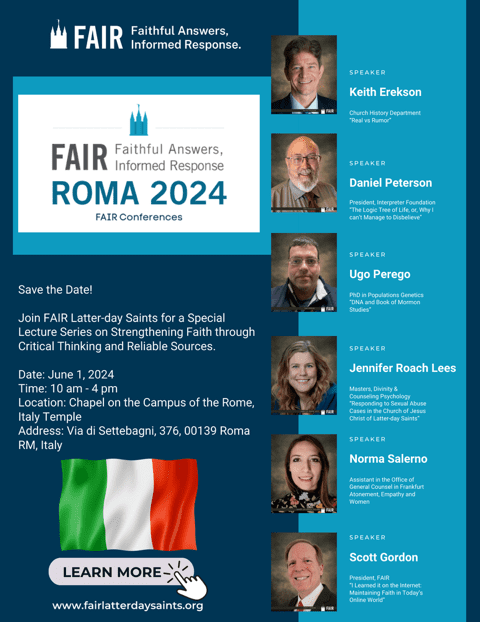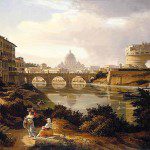
These new articles went up yesterday on the Interpreter Foundation website. My apologies for being late in calling attention to them; the eight-hour time difference between Rome and home throws me off my routine in some ways:
“The Seven Women Seeking the Bridegroom: Isaiah 4:1 as Transition Point in a Redemption Allegory,” written by Jared T. Marcum
Abstract: Nephi laboriously copied many of the words of Isaiah in hopes that his readers would rejoice in Christ. While Isaiah 4:1 (2 Nephi 14:1) is generally not viewed as Messianic, there may be an allegorical interpretation that would place this verse among Isaiah’s other Messianic writings. A pre-Nicene patristic writer, Victorinus of Poetovio, interpreted the seven women of Isaiah 4:1 as representing the seven churches of the Apocalypse and the one man as Christ. Victorinus’s Christ-centered interpretation of Isaiah 4:1 has received very little attention in modern scholarship. This paper uses textual analysis to determine if a Christ-centered allegorical interpretation may be considered a strong reading of the verse and the surrounding text (Isaiah 3–4). The results of this analysis show that Isaiah 4:1 may symbolize Zion’s turning point in a doctrinally rich allegory of Zion’s sin, sorrow, repentance, and redemption through Jesus Christ.
“Interpreting Interpreter: Seven Women Take Hold,” written by Kyler Rasmussen
This post is a summary of the article “The Seven Women Seeking the Bridegroom: Isaiah 4:1 as Transition Point in a Redemption Allegory” by Jared T. Marcum in Volume 61 of Interpreter: A Journal of Latter-day Saint Faith and Scholarship. All of the Interpreting Interpreter articles may be seen at https://interpreterfoundation.org/category/summaries/. An introduction to the Interpreting Interpreter series is available at https://interpreterfoundation.org/interpreting-interpreter-on-abstracting-thought/.
The Takeaway: Marcum explores a Messianic interpretation of Isaiah 4:1—the prophecy that “seven women shall take hold of one man.” He concludes that the verse may mark a point of transition in an allegory of Zion’s path of sin, sorrow, and repentance as she takes hold of Christ, the “one man,” and is redeemed by his mercy and grace.

A standard claim of atheist polemicists is that Christian belief, or religious belief in general, grows out of ignorance, is out of touch with new developments in science and scholarship, or is simply out of date, and, therefore, should be tossed out. The argument, such as it is, is seldom overtly stated. More often, we are presented with a proposition that pretends to be either the obvious and undeniable conclusion of an unstated syllogism, or, simply, intuitively apparent to all Deep Thinkers. The well-publicized “Jesus Seminar,” for example, announces that “the Christ of creed and dogma, who had been firmly in place in the Middle Ages, can no longer command the assent of those who have seen the heavens through Galileo’s telescope.”[1] Why this should be so, and what Galileo’s primitive little telescope has to do with the central doctrines of Christianity, is never made clear, although the Seminar (in a rather obvious bout of self-congratulation) dedicates its book to the Italian astronomer’s memory. But one can hardly fail to be reminded, in this context, of an exchange in C. S. Lewis’s early novel The Pilgrim’s Regress—a novel that seems more prescient with each passing year. The conversation revolves around the “Landlord,” who, in Lewis’s allegory, represents God:
“But how do you know there is no Landlord?”
“Christopher Columbus, Galileo, the earth is round, invention of printing, gunpowder!!” exclaimed Mr. Enlightenment in such a loud voice that the pony shied.
“I beg your pardon,” said John.
“Eh?” said Mr. Enlightenment.
“I didn’t quite understand,” said John.
“Why, it’s plain as a pikestaff,” said the other. “Your people in Puritania believe in the Landlord because they have not had the benefits of a scientific training. For example, I dare say it would be news to you to hear that the earth was round—round as an orange, my lad!”
“Well, I don’t know that it would,” said John, feeling a little disappointed. “My father always said it was round.”
“No, no, my dear boy,” said Mr. Enlightenment, “you must have misunderstood him. It is well known that everyone in Puritania thinks the earth flat. It is not likely that I should be mistaken on such a point. Indeed, it is out of the question.”[2]
[1] Robert W. Funk, Roy W. Hoover, and the Jesus Seminar, The Five Gospels: The Search for the Authentic Words of Jesus (San Francisco: HarperSanFrancisco, 1997), 2.
[2] C. S. Lewis, The Pilgrim’s Regress: An Allegorical Apology for Christianity, Reason, and Romanticism (Grand Rapids, Mich.: Eerdmans, 1992), 20-1.

We held the first of the three European FAIR conferences today. All of the presentations except one were quite good. Attendance was fairly sparse at first but it picked up later in the day. Happily, the speeches were not only live-streamed but recorded. They will be up on the FAIR website in a while. Probably, though, not for a month or two. One of the principal people who will put them up is over here with us right now, and she’s pretty busy.

Here are a couple of shockers that I’ve lately drawn from the Christopher Hitchens Memorial “How Religion Poisons Everything” File™:
- “How the Church of Jesus Christ is helping vulnerable migrants: The church donated $3.4 million to Project HOPE to improve the health of migrant and vulnerable populations in Colombia, Ecuador and Venezuela”
- “Latter-day Saints clear debris, serve neighbors after Arkansas tornadoes: At least 12 tornadoes killed 8 people, destroyed homes and left thousands without power during the weekend of May 25”
Someday, theism’s reign of terror will end. Not yet, though.
Posted from Rome, Italy













